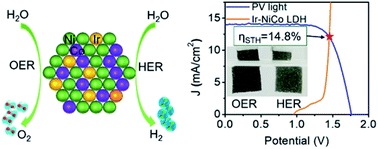Atomic Ir-doped NiCo layered double hydroxide as a bifunctional electrocatalyst for highly efficient and durable water splitting†
Abstract
Developing cost-effective bifunctional electrocatalysts with low kinetic overpotential and superior stability for both the oxygen evolution reaction (OER) and hydrogen evolution reaction (HER) is crucial to build a water splitting system for advancing the production of hydrogen fuel. Herein, we report a bifunctional catalyst by doping atomic Ir into a NiCo layered double hydroxide (LDH) using a facile atmospheric solvothermal method and subsequent spontaneous galvanic displacement. The as-synthesized atomic Ir-doped NiCo LDH exhibits much better durability for over 200 h than the NiCo LDH with the loading of Ir nanoparticles, due to the fine doping of atomic Ir into the crystal lattice of LDH. Benefiting from the synergistic effects in the HER/OER processes, as well as the large electrochemically active surface area and the improved electrical conductivity, the atomic Ir-doped NiCo LDH couple results in an unprecedented performance for overall water splitting with a low cell voltage of 1.45 V at 10 mA cm−2 in a 1.0 M KOH electrolyte. Finally, a practical solar-driven water splitting system with a solar-to-hydrogen efficiency of 14.8% is demonstrated, outperforming the state-of-the-art analogous systems based on ordinary Si solar cells.



 Please wait while we load your content...
Please wait while we load your content...